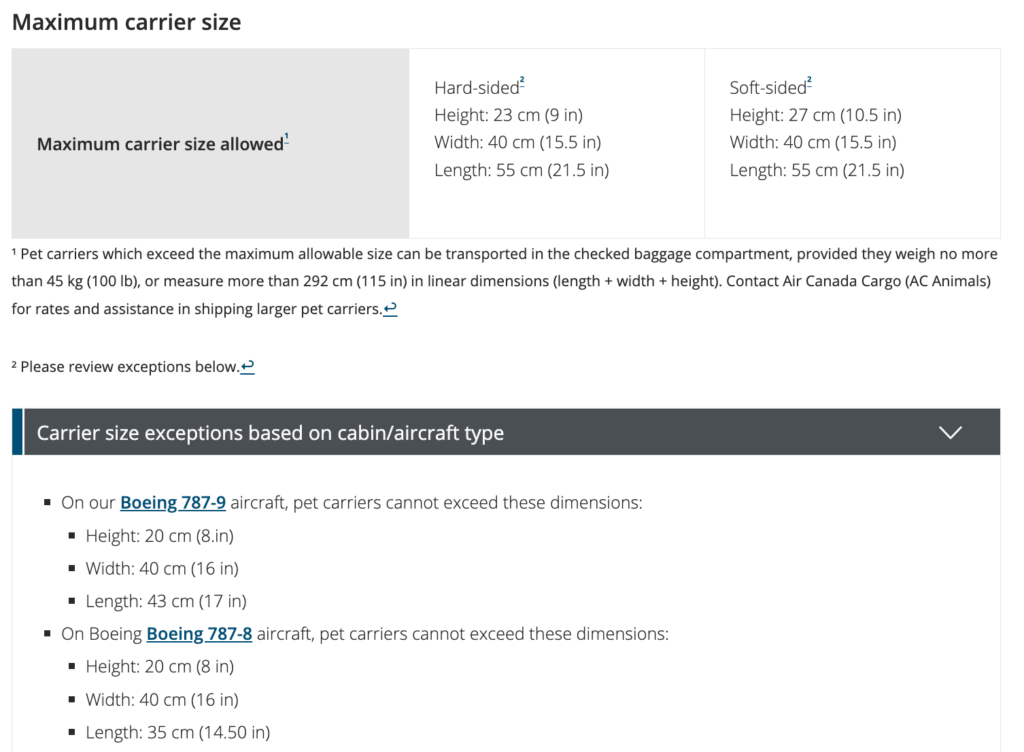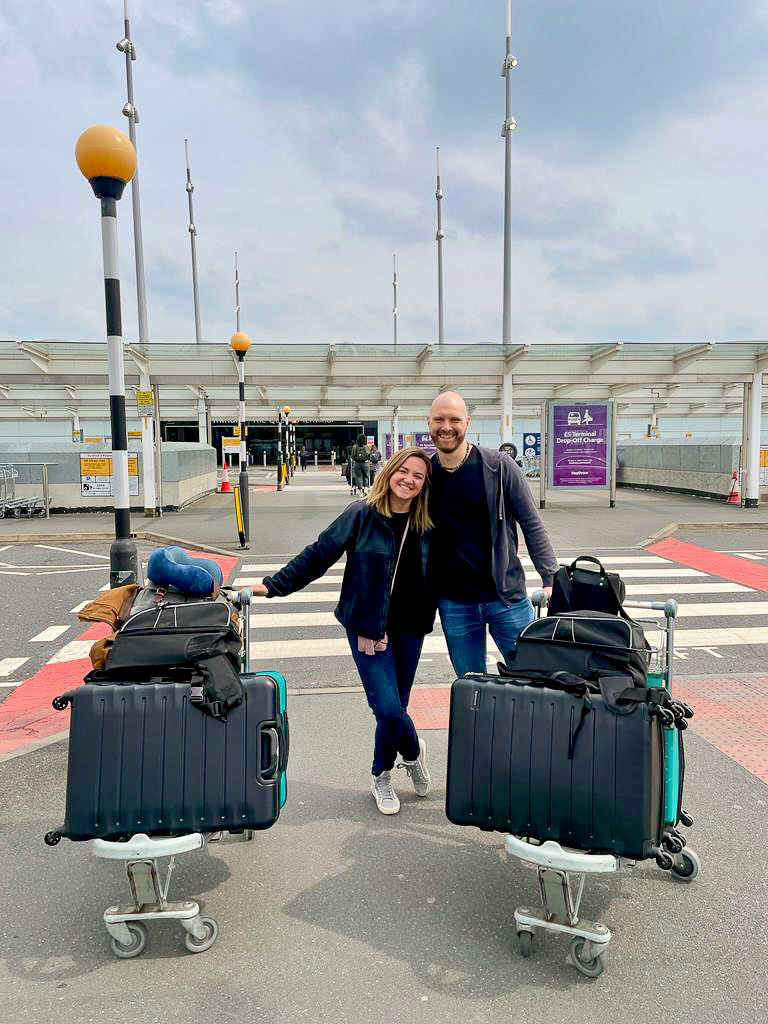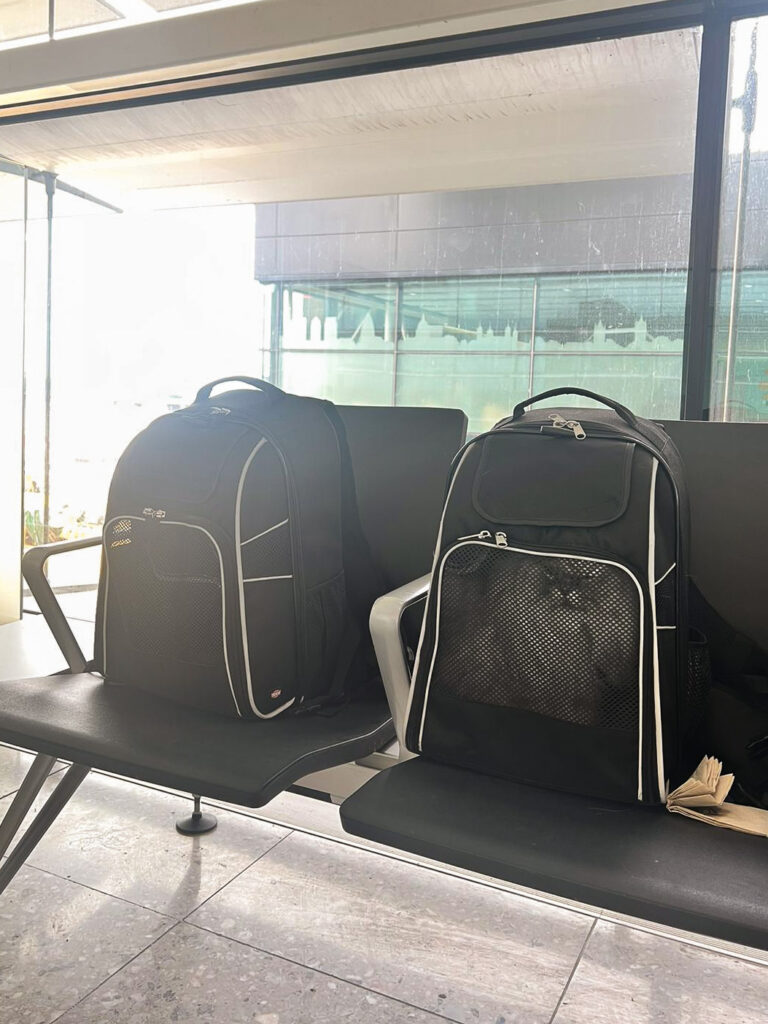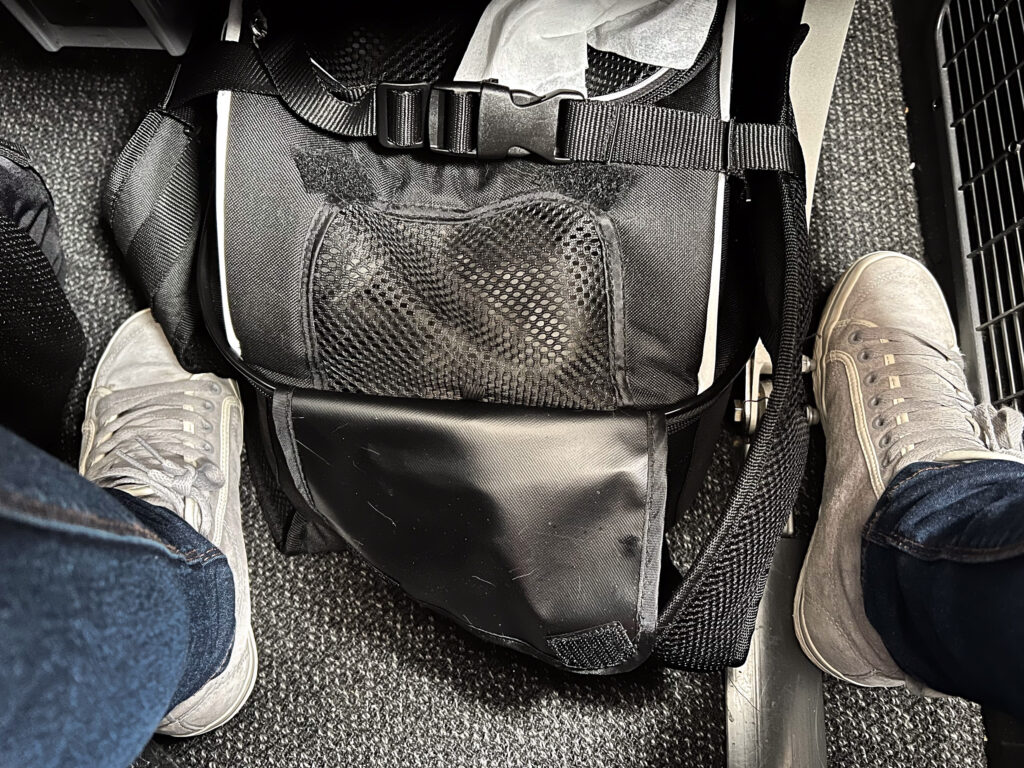Planning to travel by plane with your beloved cat can be a stressful experience. It was certainly one of the most stressful things for us when we were planning to move from England to Canada. Looking back, we should have been more relaxed about flying with our cats! We spent a lot of time preparing, but once the day came, everything went surprisingly smoothly. Much smoother than we expected.
Keep in mind that there are endless variables when it comes to traveling with cats, so it’s impossible to cover every single scenario. As such, we will only talk about what we’ve learned from our particular experience: two adults flying with two cats from the UK (London) to Canada (Vancouver) with Air Canada. Our guide may not provide every answer, but at least you’ll know what you need to consider when planning your trip.
At some point, we considered using a specialist company to fly the cats for us, but the cost was way too high (£1,100-1,600), plus we didn’t want to be separated from them. However, in some cases (travel logistics, the size of the cat etc.), using a specialist company might be the only option.
With that said… let’s assume that you’re taking your cat(s) with you.
Health certificates required for flying with cats
The first step is to figure out what documents you’ll need for the cat, and the best place to look is the government website of the country you’re heading for. For Canada, you can find all the information here.
If you’re travelling from the UK (where you’re travelling from matters), you only need a certificate from your vet confirming that your cat doesn’t have rabies. You can get your cat vaccinated against rabies, but you’ll still need a certificate.
The certificate must be:
- in English or French,
- issued and signed by a licensed veterinarian,
- include animal details (age, breed, sex, colour/markings, weight, and microchip/tattoo number if applicable).
- include confirmation of rabies vaccination, date of vaccination, trade name and the serial number of the licensed vaccination, duration of immunity (otherwise, it will be considered valid for 1 year)
- have the name and signature of the licensed veterinarian that issued the certificate and the date it was signed
Also, check the specific requirements of the airline you’re considering. Some airlines might have their own set of rules for travelling with pets.
In our case, we decided to also get ‘fit to fly’ certificates for our cats, even though they weren’t required. We were just a bit paranoid and wanted to cover all bases. But no one even looked at them and they were £90 per cat, so it was a completely unnecessary expense. If you do need them or want to have them, you’ll have to arrange them 48 or 72 hours before the flight.
Flying with cats: In-cabin or cargo hold?
Alright, so you know what documents you’ll need to fly with your cat. But now, here comes the big question – Is your cat going to travel in the cabin or in the cargo hold? To be honest, in most cases the airline will make this decision for you because only a handful of airlines allow cats in the cabin. Air Canada is one of those that do (at least when you’re travelling from the UK.)
If you’re thinking about taking your cat into the cabin, you have to keep in mind that there will be a lot of restrictions:
- Most airlines allow only one pet per person.
- If you’re travelling with someone else, you most likely won’t be able to sit together.
- The pet has to be relatively small – most cats, rabbits, etc. are fine. But when it comes to dogs, only small dogs are allowed in the cabin.
- The pet must be able to stand and turn around in the carrier and the carrier must fit under the seat in front of you… This is challenging, to say the least, but we’ll tell you more about that later 😉.
- Your pet must stay in the carrier for the duration of the flight.
Cargo Hold Travel
Assuming you have the choice between the cabin and the cargo hold, which option is better for flying with cats? We dedicated a lot of time to researching it, and there isn’t a straightforward answer. The main benefits of putting your cat in the cargo hold are:
- It will have more space.
- There will be no complaints from other passengers.
- Once the plane is in the air, your cat will most likely just go to sleep.
But there are some downsides too:
- You won’t be around to comfort your cat.
- You will be separated from it for quite a long time.
- You won’t know how your cat is being handled.
A key thing to remember is that some airlines might not allow transporting flat-faced breeds like our Scottish Folds in the cargo hold due to potential breathing issues caused by stress (even though the cargo hold is pressurised and heated). Air Canada is one of these airlines, so our choices were:
- Fly with a different airline.
- Send our cats separately.
- Take our cats to the cabin with us.
In-cabin Travel
Ultimately, we didn’t want to be separated from them, so we decided to stick with Air Canada and fly with our cats in the cabin. The main benefit is that your cat travels just like you, and you can keep an eye on it.
The downsides you may want to consider:
- The carrier has to fit under the seat in front of you, so your cat won’t have much space.
- You may be asked to sit in a different seat (and you may be told that on the day of the flight).
- You can carry just one cat.
- Other passengers might not be happy about traveling close to your cat – allergies could be one reason, or your cat might get a bit noisy or have an ‘incident,’ if you know what we mean. By the way, this was our major worry, but there’s a lot of background noise in the cabin so even when our cats meowed, their sounds were hardly noticeable.
If your cat is going to travel in the cargo hold, the process is quite straightforward. You’ll need to follow your airline’s guidelines for selecting a suitable carrier, pay an additional fee, and make sure you arrive at the airport early to check in your cat before you check in.
Once you arrive at your destination, you’ll need to wait for a bit as your cat is unloaded from the plane and goes through customs.
You’ve decided to fly with your cat in the cabin, what’s next?
First of all, you need to check the type of plane you’ll be flying on. Each airline has some standard carrier size limits, but some planes have distinct restrictions. Click on the ‘Details’ link to see more information about your flight and find the type of the plane. Then go to your airline’s website, find the page about travelling with pets and look for restrictions for your plane type. See example below:

Make sure you book your tickets well in advance and call your airline’s customer support to check if you can fly with your cat. There’s usually a limit on the number of pets permitted in the cabin.
You’ll need to pay extra for your cat ($100 in the case of Air Canada) and the carrier will count as your carry-on luggage. This means you’ll only be allowed a small bag on board.
Flying with cats: Choosing the right carrier
Now that you have all the information you need, it’s time to pick the right carrier for your cat. This took us ages, mainly because for our plane, the max height of the carrier was much less than on most other planes.
First things first, definitely go for a soft case. This gives you the flexibility to choose a carrier that’s slightly larger than the dimensions specified by the airline. When we rang Air Canada’s customer support, we were told that a soft carrier can exceed the maximum allowed dimensions by 1-2 inches.
When you start searching for airline-approved pet carriers, you’ll find that a lot of them have similar dimensions, but they’re too big for a lot of the planes (like in our case). This is because they’re designed to fit under the largest allowed space. For example, Air Canada allows carriers up to 10.5in x 15.5in x 21.5in. But on our plane (Boeing 777-300ER), the available space was only 8.25in x 15in x 17in, which is considerably smaller. Honestly, finding a carrier that was both compact enough to fit under the seat and big enough for our cats to be able to stand up was a real challenge. Our solution was to get pet backpacks 😺 These backpacks were a good size, our cats were able to stand up when their backpack was in an upright position, and they could reasonably comfortably turn around when the backpack was under the seat.
Flying with cats: What else you might need?
The last thing to do is get some supplies for the flight. We had with us:
- Veterinary mats inside the carries to soak up any ‘spillages’
- Pet wipes in case we had to clean up our cats during the trip
- Calming wipes (Pet Remedy)
- Canned tuna to give them as a treat after the flight. You can’t bring any pet food to Canada (unless it’s from the US) but canned tuna is fine.
You may be tempted to give your cat some food or treats at the airport or during the flight, but we’d advise against it. The journey will be stressful for your cat so it’s likely it won’t want to eat anyway. Plus, if it does eat, there’s a higher chance it could get sick during the flight (this happened to one of our cats after he got 2 little treats on the flight).


On the day of the flight
Do not feed your cat any food 4-6 hours before the flight.
Arrive at the airport at least 1 hour earlier than you usually do. In our case, everything went smoothly, and everyone at Heathrow Airport was friendly and helpful. However, even though it was a quiet day at the airport, it still took us longer than usual to check-in. One of the reasons was that we had to wait for a supervisor while checking in our bags, as the lady checking us in didn’t know what to do about our cats.
During the check-in, the supervisor asked to see rabies vaccination certificates and checked (very briefly) if the cats had space to move around in their carriers.
When our stuff went through the X-ray machine, one of the airport staff held onto our cats in their carriers. Once we were through, we went to a private examination room. The cats were let out of the carriers and the carriers were screened through the x-ray machine. If your cat is wearing a harness, you’ll need to remove it for the X-ray.
Both our cats were fairly calm at the airport. They only meowed occasionally, usually when there was more noise or unfamiliar smells (e.g. the smell of kerosene before we entered the terminal).
Flying with cats: on the plane
Once we were on board, nobody asked us anything. We simply put the carriers under the seats in front of us and settled in for the flight as usual.
The flight wasn’t particularly comfortable with the carriers restricting leg space, but it was okay. If you’re worried about your cat having limited space in the carrier, it might actually be more comfortable than you 😉
Even though one of our cats hates travelling (when we go to the vet, she meows throughout the whole journey), she was perfectly fine at the airport and on the plane. She slept most of the time and only meowed occasionally, but she calmed down as soon as we put one hand in the carrier. This need for reassurance made us realise that we made the right decision to bring our cats into the cabin. Your cat would have to be VERY vocal for the meows to be noticeable by other passengers, so don’t worry about it (there’s a lot of cabin background noise).

After the flight
When we arrived in Canada, the customs officer just looked at our cats’ documents – it was really quick and straightforward. He didn’t check if the cats match the description in the documents (not even if they are cats!).
And that’s all there was to it 😊 We grabbed a taxi and went to our Airbnb. It took our cats around 3 days to fully acclimatise – they meowed a bit and looked for ‘safe’ places in the apartment, but they settled into their new place pretty fast.
A few final tips for flying with cats:
- Take with you (or buy after landing) something that will remind your cat of home – for our cats it was their favourite toy and a scratching post.
- Leave some familiar smells around the apartment (e.g. the shirt you wore on the flight).
- Make sure your cat has a cozy space where it can hide (e.g. a wardrobe)
- Try not to leave your cat alone in the apartment for the first few hours (or even a day) and give it as much assurance as possible.
- Don’t be surprised if your cat doesn’t do its business for the first couple of days – it took our cats 3 days to go back to their normal potty routine. We tried giving them food with pumpkin puree, but it didn’t work. Strangely, they both decided to drop their ‘cargo’ right after we got them a new scratching post (literally within 5 minutes of giving it a scratch 😆). If your cat goes without pooping for 3-5 days, you might have to take it to the vet.
If you have any questions about flying with cats, feel free to comment below. Also, make sure you head over to our Instagram and watch our stories from the flight in the highlights section, and this reel narrated by our cat Einstein 😊.
That’s it! We hope you have a safe flight with your cat!